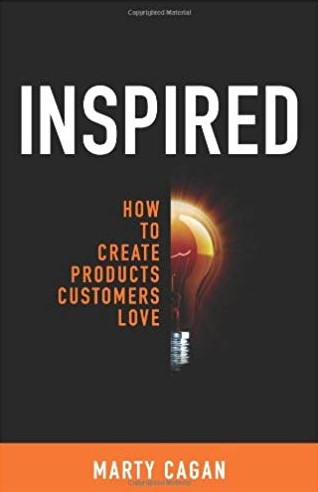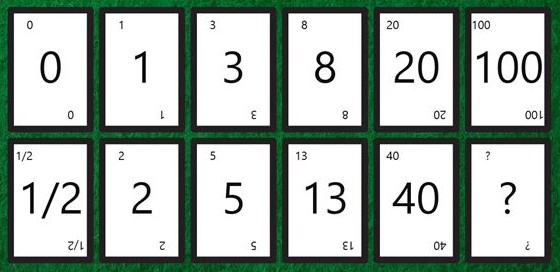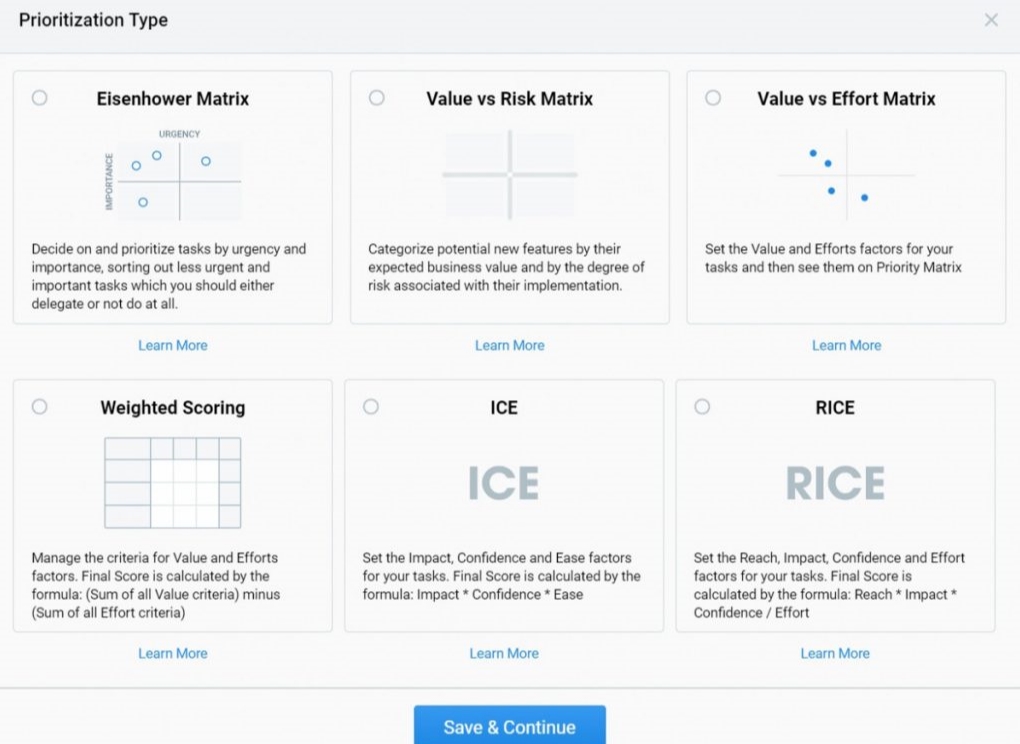What is prioritization about? Product managers will agree that it’s rather critical to choose the right features for development, filter the most important of them and skip less urgent ones. This is all about the art of prioritization.
If you are not sure about your prioritization skills and want to get more, this quick guide will assist to discover how to find the evaluation criteria for your product and how to select appropriate strategic growth metrics. You will also find out how to offer more value to customers and establish all internal processes inside your team with the help of prioritization methods.

In general, product management involves 3 essential stages:
Many companies often face the problem when the team's time is spent on developing features that no one needs. This problem is especially relevant for start-ups with limited budget and timeframes. By the way, intuition is not always helpful in this case.
There is a good gradation of product managers, identified by Marty Cagan in his book “Inspired”:

Actually, it's rather critical to be able to properly prioritize especially in the environment of severe competition and uncertainty.
Prioritizing features should start with managing a product strategy.
If you clearly define a product strategy at the very start, it will inform your product timeline, satisfy your clients and help with the internal company's needs. When there is no clear strategy and a smart product timeline, then it’s not better time to start prioritizing features.
Let's look at how it is happening in Hygger.io, the project management tool with built-in prioritization.

That's how we do it:
We set goals for 2 months and select appropriate metrics, then collect and choose ideas that can improve these metrics. We apply the Lean prioritization of ideas, conduct features scoring, and write the task for the features that have won. That is all! The features are ready for development.
Looks unclear? Let’s dive into the details.
We have a 2-week trial and we want to increase the number of companies that buy a paid subscription after the trial. This is the main goal for the next 2 months. It's also critical to differentiate from competitors as over 500 project management systems are available on the market today.
We use basic and additional metrics that widely known. The basic metric is a trial-to-paid conversion. Additional metrics are the conversion of visitors into registration, Activation (AHA moment) and Retention.
AHA-moment is the moment when the user has understood the value of the product or even used this value on the real task. Every product has its own value.
The sources of feedback may be different. For example:
There is an obvious need to constantly maintain order in our product backlog, as we have a lot of feedback. It helps us easily find the right things and not be distracted by minor ones.
We structure our product backlog in the following way:
We can also link all the requests of customers with features.
Accumulating new ideas, we evaluate them with the help of the Lean Prioritization approach. We use a simple 2×2 matrix with two axes – complexity and value. Value means what contribution the feature gives to the product. Complexity visualizes the effort required to implement a feature.

Using the Backlog Priority Chart, we are able to optimize priorities by defining important and less important tasks.
Value can be understood in different ways. In our case, features get Value if they:
Here it's rather pointful to mention a Planning Poker process that looks helpful at this stage:

Not all features get scoring, just those that have won in Lean Prioritization (as the scoring is quite a labor-intensive act).
We evaluate every feature according to the selected criteria, according to scale 0-10. Then we multiply these values by the weights and get a final numerical score that allows us to compare features to each other.

Criteria for scoring may be different:
Perhaps, there is no ideal way to prioritize and the method described above may seem complicated somehow. That’s why you can enjoy other available prioritization frameworks, such as:
Feel free to try them all!

In order to improve your prioritization skills, you may apply one of the dozens of powerful prioritization techniques and methodologies well known all over the world.
One of the most completed lists with such methods is Daniel Zacarias' collection where he has assembled great prioritization techniques and grouped them according to two external/internal and quantitative/qualitative properties. The most interesting of them are:
It'd be logical to sum up the results that this process brings:
How do you find that process of choosing features for development?
Would you like to add something? Perhaps, some points need to be replaced. Please, leave your feedback below :)
If you are not sure about your prioritization skills and want to get more, this quick guide will assist to discover how to find the evaluation criteria for your product and how to select appropriate strategic growth metrics. You will also find out how to offer more value to customers and establish all internal processes inside your team with the help of prioritization methods.

Feature prioritization in product management: why is it important?
In general, product management involves 3 essential stages:
- user research
- planning
- execution
Many companies often face the problem when the team's time is spent on developing features that no one needs. This problem is especially relevant for start-ups with limited budget and timeframes. By the way, intuition is not always helpful in this case.
There is a good gradation of product managers, identified by Marty Cagan in his book “Inspired”:
- Backlog administrator – the CEO who is responsible for decisions.
- Roadmap administrator – stakeholders who are responsible for decisions.
- Real product manager – a product manager who is responsible for decisions. The info described below will be useful for this kind of manager.

Actually, it's rather critical to be able to properly prioritize especially in the environment of severe competition and uncertainty.
The basics of prioritization
Prioritizing features should start with managing a product strategy.
If you clearly define a product strategy at the very start, it will inform your product timeline, satisfy your clients and help with the internal company's needs. When there is no clear strategy and a smart product timeline, then it’s not better time to start prioritizing features.
Let's look at how it is happening in Hygger.io, the project management tool with built-in prioritization.
The process of prioritization

That's how we do it:
We set goals for 2 months and select appropriate metrics, then collect and choose ideas that can improve these metrics. We apply the Lean prioritization of ideas, conduct features scoring, and write the task for the features that have won. That is all! The features are ready for development.
Looks unclear? Let’s dive into the details.
Goals
We have a 2-week trial and we want to increase the number of companies that buy a paid subscription after the trial. This is the main goal for the next 2 months. It's also critical to differentiate from competitors as over 500 project management systems are available on the market today.
Appropriate metrics
We use basic and additional metrics that widely known. The basic metric is a trial-to-paid conversion. Additional metrics are the conversion of visitors into registration, Activation (AHA moment) and Retention.
AHA-moment is the moment when the user has understood the value of the product or even used this value on the real task. Every product has its own value.
Collecting ideas
The sources of feedback may be different. For example:
- Customer support (Intercom.com)
- Product analytics (Amplitude.com)
- NPS. How likely are you to recommend us to your friends and colleagues? (Satismeter.com)
- The analysis of competitors (Feedly.com)
- Interviews (Custdev.com)
- Experiments and A/B testing (Optimizely.com)
- Reviews (Capterra.com)
- Surveys (Typeform.com)
- UX testing (Usertesting.com)
Organizing ideas
There is an obvious need to constantly maintain order in our product backlog, as we have a lot of feedback. It helps us easily find the right things and not be distracted by minor ones.
We structure our product backlog in the following way:
- by components (backend, frontend, API, mobile apps)
- by the field of application (UX, marketing, tech debts, bugs)
- flag the most strategic and important
- link insights and features to understand features relevance.
We can also link all the requests of customers with features.
Lean prioritization
Accumulating new ideas, we evaluate them with the help of the Lean Prioritization approach. We use a simple 2×2 matrix with two axes – complexity and value. Value means what contribution the feature gives to the product. Complexity visualizes the effort required to implement a feature.

Using the Backlog Priority Chart, we are able to optimize priorities by defining important and less important tasks.
- Quick Wins are features that give a lot of value but which can be very quickly realized.
- Big Bets — the features that can bring great value, but they are difficult to implement.
- Maybes – tasks and features that do not bring much value, but are easily implemented. They can be fully realized later.
- Time Sinks — the features do not need priority and we can skip them.
Value can be understood in different ways. In our case, features get Value if they:
- Improve trial-to-paid conversion (metric movers).
- Help to attract new users (Aha-moment).
- Help to keep current users
- Add values to the product and separate us from competitors.
Here it's rather pointful to mention a Planning Poker process that looks helpful at this stage:
- People meet altogether
- They choose a leader who takes a particular idea
- The group discusses it and each participant evaluates the idea according to the Fibonacci sequence
- The Leader opens all the cards
- Participants who put max and min explain their decision
- Then everybody tries to find consensus and move on to the next idea.

Applying Weighted Scoring
Not all features get scoring, just those that have won in Lean Prioritization (as the scoring is quite a labor-intensive act).
We evaluate every feature according to the selected criteria, according to scale 0-10. Then we multiply these values by the weights and get a final numerical score that allows us to compare features to each other.

Scoring criteria
Criteria for scoring may be different:
- Target metrics
- Value for users
- Pirate metrics (AARRR)
- Increases income
- Helps to retain current customers
- Helps to acquire new customers
- Strategic value
- Strong innovation
- Time and cost of development
- Time and cost of implementation
- Is needed for many users
- How often is needed
- Many competitors have it
- Confidence in success
- Expectation or delighting according to Kano approach and so on and so forth.
Perhaps, there is no ideal way to prioritize and the method described above may seem complicated somehow. That’s why you can enjoy other available prioritization frameworks, such as:
- A simple 2x2 matrix based on the Eisenhower model (Value vs Effort)
- RICE scoring model
- ICE Score model
Feel free to try them all!

Moreover!
In order to improve your prioritization skills, you may apply one of the dozens of powerful prioritization techniques and methodologies well known all over the world.
One of the most completed lists with such methods is Daniel Zacarias' collection where he has assembled great prioritization techniques and grouped them according to two external/internal and quantitative/qualitative properties. The most interesting of them are:
- MoSCoW prioritization technique
- Pareto’s rule
- Value vs Cost method
- Value vs Complexity method
- Story Mapping visual methodology
- Opportunity Scoring methodology
- Quality Function Deployment
- Speedboat technique
- Feature buckets method
- KJ method
- Buy a feature gaming method
To sum it up
It'd be logical to sum up the results that this process brings:
- The degree of influence of gut feeling in decision-making has been decreased
- Strategic indicators are growing steadily
- Return HIPPO (highest paid person’s opinion)
- The customers get more value per unit of time
- The team understands WHY we are creating specific features
- Minor ideas are being hidden and do not irritate. Anyway, 80% of ideas will never be realized.
How do you find that process of choosing features for development?
Would you like to add something? Perhaps, some points need to be replaced. Please, leave your feedback below :)